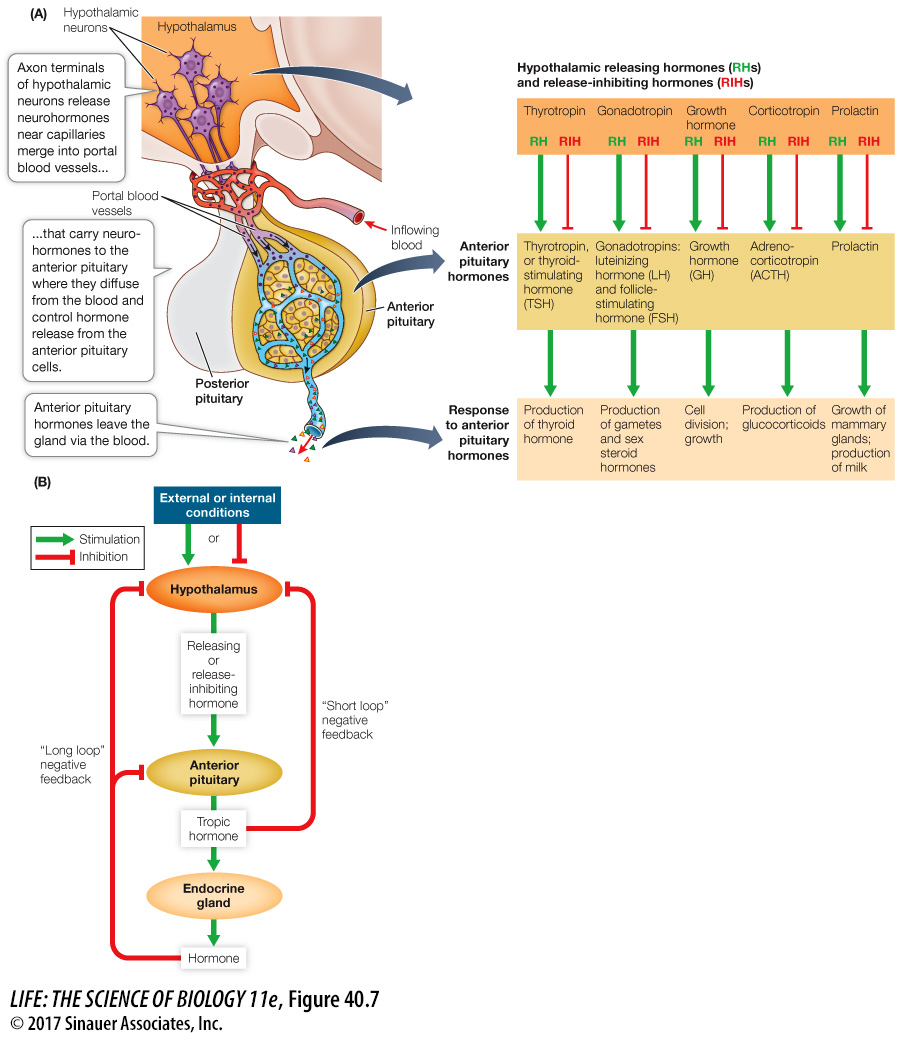Hypothalamic neurohormones control the anterior pituitary
Hypothalamic neurons do not extend into the anterior pituitary as they do into the posterior pituitary. So how do the neurohormones produced by hypothalamic neurons reach the anterior pituitary cells they control? The pituitary is connected to the brain by the pituitary stalk (Focus: Key Figure 40.7). Within that stalk are hypothalamic–pituitary portal blood vessels. The hypothalamic cells secrete neurohormones at the bottom of the hypothalamus where the stalk begins. The neurohormones diffuse into the portal blood vessels that begin there, and are carried in the blood to where the portal vessels end in the anterior pituitary. Hypothalamic neurohormones are released in such tiny amounts that they were only hypothesized to exist before the technology was developed to isolate and characterize their structure.
focus: key figure

Figure 40.7 The Anterior Pituitary Is Controlled by the Hypothalamus Cells of the anterior pituitary produce tropic hormones that control other endocrine glands, as well as several other peptide and protein hormones. These cells are controlled by neurohormones produced in the hypothalamus and are called releasing or release-inhibiting hormones. These neurohormones are delivered through portal blood vessels that run between the hypothalamus and the anterior pituitary through the pituitary stalk.
Question
Q: Melanocyte stimulating hormone (MSH) is an anterior pituitary hormone (not shown in Figure 40.7A). When anterior pituitary cells are grown in culture they release MSH into the medium. If extracts of the hypothalamus are added to the medium, the release of MSH decreases. What do these results tell you about the hypothalamic control over MSH producing cells?
These results suggest that cells in the hypothalamus are producing an MSH release inhibiting hormone.
In the 1960s two large teams of scientists led by Roger Guillemin and Andrew Schally initiated the search for these hypothalamic secretions. Massive numbers of hypothalami from pigs and sheep were collected from slaughterhouses and shipped to laboratories. One extraction effort began with the hypothalami from 270,000 sheep and yielded only 1 mg of purified thyrotropin-releasing hormone (TRH). TRH was the first hypothalamic release-stimulating hormone to be isolated and characterized. It turned out to be a simple tripeptide consisting of glutamine, histidine, and proline. It causes certain anterior pituitary cells to release the tropic hormone thyrotropin, which in turn stimulates the activity of the thyroid gland.
Soon after discovering TRH, Guillemin’s and Schally’s teams identified gonadotropin-releasing hormone (GnRH), which stimulates certain anterior pituitary cells to release the tropic hormones that control the activity of the gonads (the ovaries and the testes). For these discoveries, Guillemin and Schally shared the 1977 Nobel Prize in Medicine with Rosalyn Yalow, who invented the technique of radioimmunoassay, which made possible the measurement of miniscule amounts of specific molecules such as releasing hormones.
Many other hypothalamic neurohormones, including both releasing and release-inhibiting hormones, are now known. The major hypothalamic neurohormones that control anterior pituitary function are listed in Figure 40.7.
